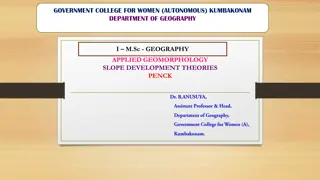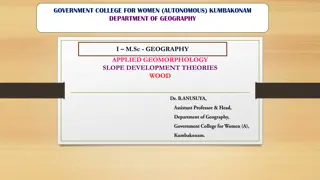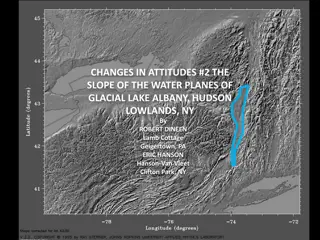Understanding Slope Development Theories in Geography - Department of Geography, Government College for Women, Kumbakonam
Slope development in geography is categorized into primary and secondary slopes, formed by processes that either promote or decrease relief. This involves erosion, weathering, and deposition processes, influenced by factors like lithology, climate, tectonic movements, and vegetation cover.
Download Presentation

Please find below an Image/Link to download the presentation.
The content on the website is provided AS IS for your information and personal use only. It may not be sold, licensed, or shared on other websites without obtaining consent from the author. Download presentation by click this link. If you encounter any issues during the download, it is possible that the publisher has removed the file from their server.
E N D
Presentation Transcript
GOVERNMENT COLLEGE FOR WOMEN (AUTONOMOUS) KUMBAKONAM DEPARTMENT OF GEOGRAPHY I M.Sc - GEOGRAPHY APPLIED GEOMORPHOLOGY SLOPE DEVELOPMENT THEORIES W.M. DAVIS
UNIT: IV UNIT: IV APPLIED GEOMORPHOLOGY APPLIED GEOMORPHOLOGY - - P18GC101 SLOPE DEVELOPMENT THEORIES W.M.DAVIS P18GC101 How are slopes formed? Definition of Slope Development: Slopes can be genetically categorizes into primary slopes, formed by processes that tend to promote relief, and secondary slopes, formed by processes tending to decrease relief. Secondary slopes evolve from the erosion and modification of primary slopes.
What are slope processes? The slope processes include weathering, erosion, transport and deposition of the material. Weathering is the process by which material is prepared for transport. Weathering is the response of the materials within the lithosphere to conditions at or near its contact with the atmosphere, hydrosphere and biosphere. Erosional processes along coastlines include: (1) The direct effects of hydraulic action, wedging, and cavitation by waves; (2) abrasion (corrasion), using sand, gravel, and larger rock fragments as tools; (3) attrition of the rock particles themselves during this abrasive action; (4) salt weathering or fretting.
Definition of Slopes Although enormous literature has been built on this subject by geomorphologists, engineers, geologists, soil scientists, etc., probably there is no definition of the term slope . Most land and submarine surfaces have some slope or inclination however small. What are dead level plains also have some slope making drainage of rainfall or precipitation as sheet or channelized flow possible. However, the study of slope by geomorphologists, etc, generally considers slopes of perceptible inclination such as we see on the mountain ranges, ridges, scarps, edges of plateaus, on the flanks of monadnocks, inselbergs and on the sides of narrow deep-cut valleys.
But it may be mentioned without ambiguity that although most surfaces including practically level cultivated fields have slopes, it is the relatively spectacular slopes that form the subject of slope studies. Practically flat alluvial plains, coastal plains, or very even plateaus fall outside the purview of slope studies. Factors that Influence the Slope Development The factors influencing slope development are numerous. Lithology, tectonic characteristics and age of rocks form one set of important factors. Climate and its change constitute another. Tectonic movements and eustatic change of sea level are highly important. Vegetation by providing a protective cover or influencing hydrology or affecting transport of weathered material or otherwise must form another important factor.
Thus, Nature is as variable in the details of slopes as in several phenomena. Just as each of some 6,000,000,000 human beings has distinct stature, face, voice, build, attitude, temperament, outlook, character, etc. so is the case with each slope, in whatever site, situation and region, it may be. This makes generalization and quantification about slopes all the more baffling. This baffling variety must be borne in mind despite all the meticulous quantitative studies and quantification pertaining to slopes. According to W.M. Davis landscape is a function of structure, process and stage . Slope may be described as function of structure, process, stage and tectonics. The structure may be included under the original slope form. The effects of climate, hydrology, glaciation, vegetation, soils, biological factors and probably even tectonics may be included under process. The stage or the time factor in monocyclic or multicyclic slopes is indeed extremely important.
The original nature of the surface, e.g., the angle of inclination, its form in respect of concavity, convexity, uniformity, marked knicks or breaks and dislocated surfaces like those along faults will affect the present form of the slopes. Polycyclic nature of slopes, wherever this is the case, it is definitely an important factor to bear in mind in the correct interpretation of slopes. Variety of factors is indeed bewilderingly large and even in the same environment and microregion there may be baffling variations. Within a single climatic environment some slopes may recline whereas others retreat parallel
Although submarine slopes have been investigated by oceanographic surveys and researches, they form a subject of the future so far as their detailed analysis is concerned. Buried under the load of oceanic waters and isolated from the atmosphere their development is mostly different from the slopes on land surfaces. Thus, in the study of slopes we are concerned with the slopes on land areas. No limit to the degree of slopes appears to have been set by the students of the subject, but mostly it is the slopes which we have summarily mentioned above and which have their application in agriculture, soil characteristics, hydrology, engineering activities, etc.
Slope Formation The all landforms slopes are clearly the most common and often the most overlooked. Understanding slope processes is of particular interest to land use planners, and because slopes often reflect changes in lithology they are of particular interest to bedrock mappers. Slopes can be genetically categorizes into primary slopes, formed by processes that tend to promote relief, and secondary slopes, formed by processes tending to decrease relief. Secondary slopes evolve from the erosion and modification of primary slopes. The distinction is not always clear because primary and secondary processes do not operate independently. However, its important to understand to what degree a slope is the result of primary and secondary processes. Many slopes are paleoslopes formed under a different climatic regime.
What factors influence slope development? The factors influencing slope development are numerous. Lithology, tectonic characteristics and age of rocks form one set of important factors. Climate and its change constitute another. Tectonic movements and eustatic change of sea level are highly important. Who developed the theory of landform development? The most popular theory of landform development was given by American geomorphologist William Morris Davis. His concept of geographical cycle (or commonly known as cycle of erosion) provided a genetic classification and systematic description of landforms.
This is especially true in New England where slopes occupy the flanks of relict glacial features, such as drumlins, moraines, glacial troughs, and meltwater valleys. A slope's shape is governed by its internal structure and external processes, such as slope wash, creep and other mechanisms of sediment transport. Material deposited while in transit down the slope is termed colluvium--an unsorted mixture of rock and sediment derived from the slope face. Origins of primary slopes Tectonic (fault scarps) Depositional (volcanoes, glacial moraines, drumlins(?), dunes, alluvial fans, delta foreset, etc.) Erosional (glacial and riverine valleys, etc.) Human activity (blasted rock slopes, hydraulic mining, tailings piles, etc)
Processes acting on slopes Mass Wasting , creep, flow, fall, etc Action of water Raindrop impact (aids in the suspension of sediment) Slope wash (Horton overland flow, sheetflow) Channelized flow (rills) Subsurface flow (elluviation and solute transport, sapping, and throughflow. How process affects slope morphology Mass movement and morphology Creep leads to the development of convex upward slope segments Solifluction, slumps, and flows commonly result in concave upward profiles at their heads and convex toes of colluvium
Solifluction, slumps, and flows commonly result in concave upward profiles at their heads and convex toes of colluvium Rock fall forms a talus (scree slope)beneath a free face (cliff) Slope of talus is governed by: Angularity of sediment Rate of rock fall vs. rate of weathering and erosion of talus Pediment surfaces that lack significant debris beneath the free face develops because talus is weathered and removed faster than it is produced.
Effects of Water Surface flow (Horton overland flow, or slopewash, and channel flow): Aids the development of concave upward profiles in valleys and Convex upward profiles along divides Subsurface flow (downward percolation, throughflow and groundwater flow) Aids in elluviation (minor?mechanism of slope decline) Aids in the formation of earthflows and solifluction May lead to surface channel formation by piping (sapping).
Other factors influencing Slope Morphology 1. Geology: Slope composition and structure controls the detachability of slope material by a particular process Rock slopes: Slope is controlled by rock strength and structure. Rock strength: high strength promotes the development of a free face low strength promotes flatter slopes (fig. 1) Structure: orientation, type and abundance of planes of weakness (e.g. bedding planes & joints) Fall faces typically occur where There is an active geologic agent oversteepening the slope
Previously oversteepened slope has not yet been deeply weathered or consumed by colluvium Change in base level exhumes buried topography Soil slopes: Shape controlled more by processes Erosion by water is influenced by permeability and erodibility of slope materials and vegetative cover Sharp divides typically develop on poorly vegetated, impermeable and easily eroded slopes (fig. 2) Mass wasting is influenced by sediment characteristics (cohesiveness, grain size, sorting and angularity), degree of consolidation, and structure.
Figure 1. Slope developed on horizontal sedimentary rock, Grand Canyon, AZ. Variations in lithology strongly influence the rock slopes that flank the canyon. Cliffs of limestone and sandstone alternate with gentle slopes composed of shale. Click to enlarge. Figure 2. Slopes developed in playa sediments (Furnace Creek Formation near Zabrinskie Point, Death Valley, CA). Although Death Valley receives less than 2 inch/year of precipitation runoff is the dominant process shaping the slopes. Photo by Paul Stone, USGS,
2. Climate controls intensity of chemical vs. mechanical weathering controls vegetation and water content In arid landscapes lacking vegetation, such as those shown in figures 1 and 2, fluvial erosion is quite effective. Generalizations regarding the effects of climate: Humid Slope form is controlled by processes acting on regolith: slopes tend to be transport limited Arid/semiarid Lack of vegetation increases the efficiency of water and wind slope form is controlled by bedrock strength and characteristics: slopes tend to be weathering limited
3. Local activity: Rates of mass-wasting are promoted by: Proximity to stream, shoreline, etc. Ativity of man Rate of uplift and incision; relief Terminology used to describe slopes Slope angle. Transport limited: Rate of transport is lower than regolith formation: Weathering and soil formation rates are faster than rates of removal. Slope form is greatly controlled by creep, solifluction and similar mass movement processes, and slope wash. Weathering limited: Rates of regolith formation is slower than transport: Erosional processes, such as mass-wasting, slope wash, fluvial activity, etc., are faster than weathering (soil- forming) processes. Slopes are steep and have little to no soil (sensu stricto). Structure and lithology control the shape of the slope Angle Description 0 -0 plain 0 -30' slightly sloping 2 -5 gently inclined 5 -15 strongly inclined 15 -25 steep 25 -35 very steep 35 -55 precipitous 55 and greater vertical
Transport-limited slope in the California Coastal Range underlain by poorly consolidated sedimentary rocks and melange. These slopes have a thick active regolith. Merrimack Butte Utah. This arid climate produces weathering-limited slopes that typically lack unit 3.
Slope Development Theories - W.M.DAVIS The theory was originated with the cycle of erosion of W.M Davis. Slope decline theory explains the evolution of the slope and subsequent transformation from steeper slope to gentle one. In accordance to the cycle of erosion Slope evolution/ Slope development occurs through 4 phases such as (i) Rejuvenation (ii) Young (iii) Mature and (iv) Old. Slope decline (W.M. Davis - New England) Upper slope weathers and erodes at at faster rate so there is progressive decline of slope angle occurs. Hillslopes have a thick mantle of regolith
Davisian Theory The most popular theory of landform development was given by American geomorphologist William Morris Davis. His concept of geographical cycle (or commonly known as cycle of erosion) provided a genetic classification and systematic description of landforms. According to Davis, geographical cycle is a period of time during which an uplifted landmass undergoes its transformation by the process of land sculpture ending into low featureless plain or peneplain (which Davis called peneplane), Davis s theory was the outcome of a set of theories and models presented by him during the 1880s and 1890s.
He propounded the model of complete cycle of river life in his essay on The Rivers and Valleys of Pennsylvania (1889), and that of geographical cycle (1899) and slope evolution . He, under the concept of complete cycle of river life , postulated the cycle concept of progressive development of erosional stream valleys, and through the geographical cycle described the sequential development of landforms through time. However, Prof. Savindra Singh says that the general theory of landform development of Davis is not the geographical cycle as many of the geomorphologists believe. Davis s theory may be expressed as: There are sequential changes in landforms through time (passing through youth, mature and old stages) and these sequential changes are directed towards well defined end product development of peneplain .
What is Davisian theory of landform development? Davisian Theory: The most popular theory of landform development was given by American geomorphologist William Morris Davis. His concept of geographical cycle (or commonly known as cycle of erosion) provided a genetic classification and systematic description of landforms.
Thank you Thank you























